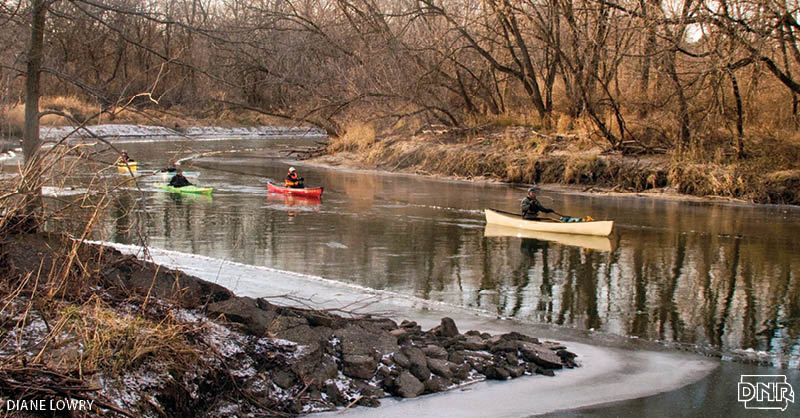
Not even cold temperatures are enough to keep the hardiest kayakers and canoers inside. If you can find open water, use these tips for safe cold-weather paddling to enjoy a trip on the water any time of year.
Basic Rules for Cold Water Paddling:
Always wear your life jacket. Your life jacket will not only keep you afloat should you dump your canoe or kayak, but will help keep your body warm in prolonged immersions. Attach a whistle in case you need to alert another paddler for help.
Never paddle alone. Paddle with at least two other paddlers when possible. Large groups are even better. If something happens, you have fellow paddlers to assist you. Nobody to paddle with? Join a local paddling club and meet others who also enjoy paddling in colder conditions.
Practice self and group rescues. Know how to save yourself and others around you.
Know the weather forecast.
Plan shorter trips in late fall, winter and early spring.
Know how to recognize the stages of hypothermia.
Always take a dry bag with dry clothes and a spare paddle.
Prepare for an emergency. Take a cell phone in a watertight case or small drybag.
File a float plan. This is something you should do regardless of the weather, but especially in cold weather. Let family and friends know where you are going and what you are doing. They should know when you are expected back and where to look if you don’t arrive.
Stretch and warm up before starting your trip. Drink a cup of tea or broth from your thermos before paddling and warm up your core. Don’t forget high-energy snacks for the trip.
Dress in proper layers. Start at the top. A warm wool knit hat will help keep your entire body warm. Remember, cold water cools the body 25 times faster than cold air, and half of your warmth escapes from the top of your head. You’ll also need polarized sunglasses. Winter conditions can mean bright surroundings and you will need polarized lenses to see obstructions in the water.
Your base layer should be moisture-wicking material next to the skin. Merino wool, nylon and polypropylene are good for keeping you warm and dry at the same time. Cotton absorbs water, will not dry and does not insulate when wet. Have an insulating layer to hold in body heat. Wool fabrics are lightweight, breathable and insulate when wet. Outer garments should be water- and wind-proof. They can be worn to peel off easily if it gets warm or to add easily if it gets too cold. A combination of splash, dry or semi-dry can be experimented with to meet your comfort needs.
Protect your hands and feet. If your fingers get too cold, you can lose the ability to hold your paddle, use a cell phone or start a fire. If your fingers become useless, you won’t be able to change into dry clothes quickly. Neoprene gloves and mittens work well. Many paddlers use gloves that attach to the paddle itself. For feet, wear water socks and insulated water shoes or boots.
Wear a wetsuit or dry suit. A dry suit, although more expensive, keeps you totally dry, while a wetsuit traps water between your skin and suit. The water in a wetsuit will warm to your body’s temperature. Remember to wear layers with both as these are not enough to keep you warm by themselves.
Use a spray skirt for your kayak or a spray cover for your canoe. These not only trap heat for your lower body, but keep cold water splashes off your lap and body.
To read more of this article, Cold Weather Paddling from the January/February 2011 issue of Iowa Outdoors magazine, order a back issue at 515-725-8200. You can also start a new subscription or give a gift subscription at www.iowaoutdoorsmagazine.com. Check out more of our articles on Pinterest on our Iowa Outdoors Magazine board or learn more about paddling on our Iowa Paddling board.
